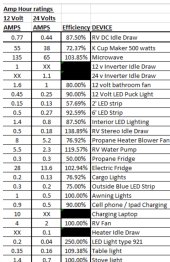Hi all and Merry Christmas. I have a question for those with much more knowledge on this than I have. I am preparing to install a Hengshan volt/amp meter to monitor my 2 - SOK 100 amp batteries in a motor home. I am also thinking about adding more storage capacity but since we have an on board 8k gen and are 90+5 of the time connected to shore power I want to make sure it is necessary. Will a shunt based monitor be able to tell me what my average real life usage is for say a 24hr period if I run just off the batteries? If not, is there an easier way? I have gone the calculation route (adding up all the watt ratings of various appliances at a guesstimated usage) but now that I have LFO batteries and a way to monitor SOC I figure measuring actual usage in real life setting would be more accurate.
Battery usage monitoring - How best to test before adding more battery capacity
- Thread starter 1holaguy
- Start date



